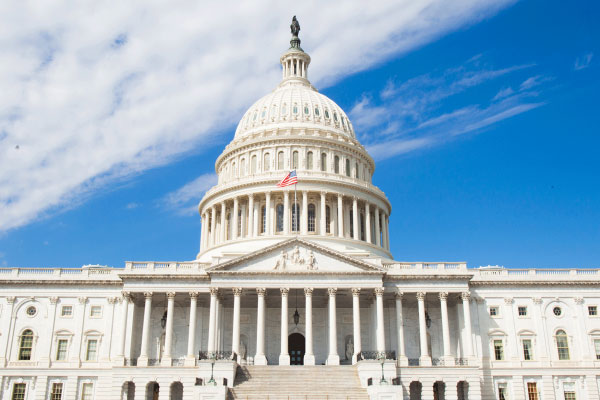Overview of the End-of-Year COVID Relief and Appropriation Bill
01/20/2021
By Madison Mason, Senior Associate, Policy
Congress passed the Consolidated Appropriations Act, 2021 on December 21, 2020, which includes $1.4 trillion in funding for the federal government through fiscal year (FY) 2021 and $900 billion for COVID-19 relief. President Trump signed the bill into law on December 27.
Stimulus Provisions:
This bill provides an extension to the Paycheck Protection Program (PPP). Specifically, it:
-
- Provides $300 billion for additional loans from the PPP and extends the program through March 31, 2021;
- Allows businesses with 300 employees or less that have sustained a 30% income revenue loss in any quarter of 2020 to apply for a second PPP loan;
- Includes 501(c)(6) organizations that are not lobbying organizations and have 150 employees or fewer;
- Expands forgivable expenses to include facility modifications and personal protective equipment (PPE);
- Simplifies loan forgiveness process for borrowers with PPP loans of less than $150,000; and
- Makes business expenses paid for with PPP loans tax deductible.
Other notable stimulus provisions include:
-
- Extension of the universal charitable deduction of $300 for individuals and $600 for couples in the above-the-line deductions for tax year 2021; and
- Direct payments of up to $600 to individuals.
Supplemental COVID-19 Provisions:
This bill also includes an additional $900 billion specifically designated for COVID-19 relief, including:
-
- Continuation of the federally enhanced unemployment benefits;
- Reduced benefits to $300 per week;
- $55 million on supply chain, devices, therapies, and vaccines for COVID-19;
- $8.75 billion for vaccine administration;
- $1.25 billion for research on long-term effects of COVID-19;
- $19.69 billion for vaccine manufacturing and procurement;
- $3.25 billion for the Strategic National Stockpile; and
- $25.4 billion for testing, contact tracing, and reimbursement for providers for COVID-19 related expenses and lost revenue.
Coverage Provisions:
The bill included several Medicare provisions. Most notably, the bill:
-
- Increases physician reimbursement under Medicare;
- Increases access to coverage information for Medicare Part B drugs;
- Extends telehealth services through December 31, 2021;
- Makes telehealth access for mental health services permanent;
- Requires Part D plan sponsors implement real-time benefit tools; and
- Covers anti-rejection transplant drugs.
The bill also addresses Medicaid concerns, including:
-
- Increasing the portion of Medicaid that the federal government covers for States;
- Extending Money Follows the Person, a federal program that provides funding to states to help keep people out of institutional settings under Medicaid, for three years; and
- Coverage of routine care costs related to clinical trials for serious or life-threatening conditions.
Surprise Medical Billing:
Also included in this bill was a bipartisan/bicameral compromise proposal to hold patients harmless to surprise medical bills. This bill requires providers to notify patients about their network status and provide an estimate of services charges before providing out-of-network services.
This bill calls for payers and providers to negotiate on an agreed-upon rate, and if they cannot find a solution within 30 days, a mediator will be brought in to solve the dispute. The mediator will review proposals submitted by the payer and the provider and will consider the median in-network rate, case complexity, and the relative market power of the insurer versus the doctor or hospital. Coverage of air ambulances was also included in this provision.
Transparency Provisions:
This bill also institutes a series of transparency provisions, including:
-
- Gives the Medicare Payment Advisory Commission (MedPac) and the Medicaid and Children’s Health Insurance Program (CHIP) Payment and Access Commission (MACPAC) access to drug pricing information, including rebate information, that is currently reported to federal agencies;
- Prohibits “gag clauses” on price and quality information between group health plans and providers; and
- Requires group health and individual market plans to annually report certain pharmacy benefit and drug cost information.
FDA Provisions:
This bill includes the following FDA provisions:
-
- Extends FDA’s rare pediatric disease priority review voucher program through FY 2024;
- Requires biological products’ exclusivity information be published in the Purple Book; and
- Requires that outdated labeling of certain generic drugs to be updated to ensure accurate information is relayed to consumers.
Appropriations:
Finally, this legislation includes full year funding for the remainder of FY 2021, with $1.4 trillion in funding for all federal agencies, including:
-
- $97 billion in discretionary funding for the Department of Health and Human Services (HHS). This is a $2.1 billion increase from FY 2020;
- $42.9 billion for the National Institutes of Health (NIH);
- $7.9 billion for the Centers for Disease Control and Prevention (CDC);
- $7.5 billion for the Health Resources and Services Administration (HRSA);
- $6 billion for the Substance Abuse and Mental Health Services Administration (SAMHSA);
- $4 billion for the Centers for Medicare and Medicaid Services (CMS); and
- $3.2 billion for the Food and Drug Administration (FDA).
For more information on COVID-19, please check out our webpage.
